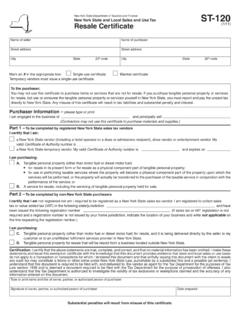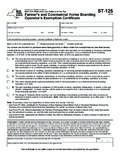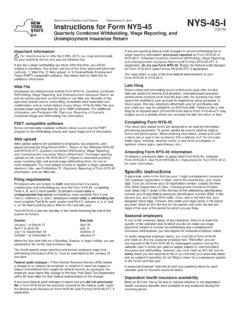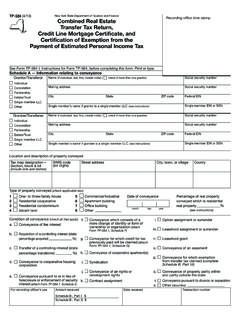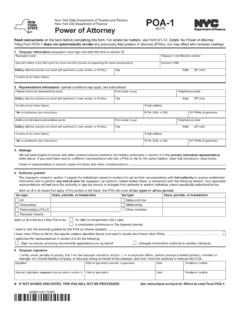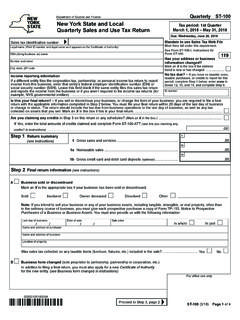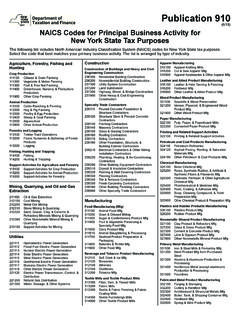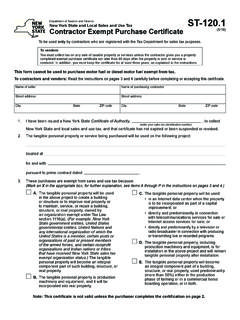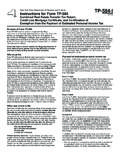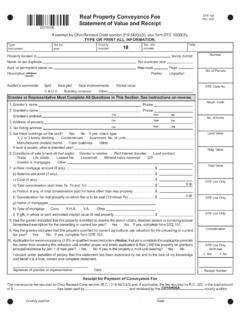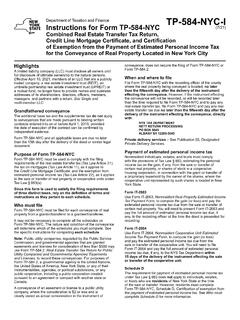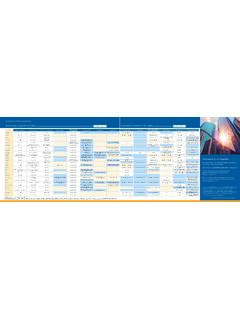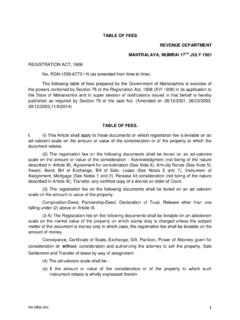Transcription of Publication 577:(2/10):FAQs Regarding the Additional Tax ...
1 Publication 577. FAQs Regarding the Additional Tax on Transfers of Residential Real Property for $1 Million or More Pub 577 (2/10). Publication 577 (2/10). Table of contents 5. 5. Frequently asked 7. NOTE: A Publication is an informational document that addresses a particular topic of interest to taxpayers. Subsequent changes in the law or regulations, judicial decisions, Tax Appeals Tribunal decisions, or changes in Department policies could affect the validity of the information contained in a Publication . Publications are updated regularly and are accurate on the date issued. This page intentionally left blank Publication 577 (2/10). Introduction Tax Law Article 31 imposes a real estate transfer tax on each conveyance of real property, or interest in real property, when the consideration exceeds $500. The tax is computed at a rate of two dollars for each $500 of consideration, or for any fractional part of $500. An Additional tax is imposed on each conveyance of real property or interest in real property used in whole or in part as a personal residence when the consideration for the entire conveyance is $1 million or more.
2 The Additional tax is computed at a rate of one percent of the consideration, or part of the consideration, attributable to the residential real property. This Publication answers frequently asked questions related to the Additional tax, often referred to as the mansion tax. The information presented in this Publication does not represent a change in any policies or procedures, but provides guidance for the relevant provisions of Tax Law Article 31 and Part 575 of the Real Estate Transfer Tax Regulations (20 NYCRR). Unless otherwise noted in the following examples, the real estate transfer tax applies to each conveyance whether or not the Additional tax is due. Although accurate, the information in this Publication has been simplified; if there is any discrepancy between this Publication and the Tax Law or regulations, the Tax Law and regulations will govern. Definitions The following terms used in this Publication are derived from definitions contained in Tax Law Article 31, or section of the New York State Real Estate Transfer Tax Regulations.
3 As necessary, they have been edited to apply specifically to the Additional tax. Real property - means every estate or right, legal or equitable, present or future, vested or contingent, in lands, tenements or hereditaments, including buildings, structures and other improvements thereon, that are located in whole or in part within the state of New York. Real property does not include rights to sepulture. Interest in real property - includes title in fee, a leasehold interest, a beneficial interest, an encumbrance, development rights, air space and air rights, or any other interest with the right to the use or occupancy of real property, or the right to receive rents, profits or other income derived from real property. It also includes an option or contract to purchase real property. It does not include a right of first refusal to purchase real property. Consideration - is the price actually paid or required to be paid for the real property, or interest in the real property, including the payment for an option or contract to purchase real property, whether or not expressed in the deed, and whether paid or required to be paid 5.
4 Publication 577 (2/10). by money, property, or any other thing of value. It includes the cancellation or discharge of an indebtedness or obligation. It also includes the amount of any mortgage, purchase money mortgage, lien, or other encumbrance, whether or not the underlying indebtedness is assumed or taken subject to. In the case of (i) the original conveyance of shares of stock in a cooperative housing corporation in connection with the grant of a proprietary leasehold by the cooperative corporation or cooperative plan sponsor and (ii) the subsequent conveyance by the owner thereof of the stock in a cooperative housing corporation in connection with the grant or transfer of a proprietary leasehold for a cooperative unit other than an individual residential unit, consideration will include a proportionate share of the unpaid principal of any mortgage on the real property of the cooperative housing corporation comprising the cooperative dwelling or dwellings.
5 conveyance - means the transfer or transfers of any interest in real property by any method, including but not limited to the sale, exchange, assignment, surrender, mortgage foreclosure, transfer in lieu of foreclosure, option, trust indenture, taking by eminent domain, conveyance upon liquidation or by receiver, or transfer or acquisition of a controlling interest in any entity with an interest in real property. Transfer of an interest in real property includes the creation of a leasehold or sublease only where (a) the sum of the term of the lease or sublease and any options for renewal exceeds forty-nine years, (b) substantial capital improvements are or may be made by or for the benefit of the lessee or sublessee, and (c) the lease or sublease is for substantially all of the premises constituting the real property. conveyance of real property will not include a conveyance pursuant to devise, bequest or inheritance; the creation, modification, extension, spreading, severance, consolidation, assignment, transfer, release or satisfaction of a mortgage; a mortgage subordination agreement, a mortgage severance agreement, an instrument given to perfect or correct a recorded mortgage; or a release of lien of tax pursuant to the tax law or the internal revenue code.
6 Grantor - means the person making the conveyance of the real property or interest therein. Grantee - means the person who obtains real property or interest therein as a result of a conveyance . 6. Publication 577 (2/10). Frequently asked questions 1) Q: What is the Additional tax? A: In addition to the real estate transfer tax imposed by section 1402 of the Tax Law on the conveyance of real property or interest in real property, Tax Law section 1402-a imposes an Additional tax on each conveyance of residential real property or interest in residential real property when the consideration for the entire conveyance is $1 million or more. 2) Q: Do all the provisions of the real estate transfer tax apply to the Additional tax? A: Generally, all of the provisions of the real estate transfer tax apply to the Additional tax, except as described later in this Publication (see questions 5 and 16). 3) Q: When is the Additional tax due? A: The Additional tax must be paid at the same time as the real estate transfer tax imposed by section 1402 of the Tax Law.
7 The taxes are paid by filing Form TP-584, Combined Real Estate Transfer Tax Return, Credit Line Mortgage Certificate, and Certification of Exemption from the Payment of Estimated Personal Income Tax, no later than the fifteenth day after the delivery of the instrument effecting the conveyance . 4) Q: What is the rate of the Additional tax? A: The rate of the Additional tax is one percent of the consideration, or part of the consideration, attributable to the residential real property. 5) Q: Who is liable for paying the Additional tax? A: The grantee is liable for and must pay the Additional tax. 6) Q: What is meant by residential real property? A: Residential real property means any premises that is or may be used in whole or in part as a personal residence at the time of conveyance , and includes a one-, two-, or three-family house, an individual condominium, or a cooperative apartment unit. Example: A building containing ten apartments sells for $ million.
8 The grantor used one of the apartments as a personal residence. This conveyance is not subject to the Additional tax since the real property conveyed is not a one-, two-, or three-family house, an individual condominium unit or a cooperative apartment unit. Example: A structure contains a store on the first level with three apartments above it. Since there are four units (the store and three apartments), the structure would not be considered a three-family house for the purposes of the Additional tax. 7. Publication 577 (2/10). 7) Q: Does residential real property include premises that have not been occupied by the grantor? A: Yes. Residential real property includes a one-, two- or three-family house, condominium unit, or cooperative apartment unit that is (or may be) rented to others for use as a residence. Example: A three-family house sells for $ million. The grantor did not occupy any portion of the house. The grantee is required to pay Additional tax of $12,000 ($ million x.
9 01). The result would be the same if the grantor had occupied any portion of the house. 8) Q: Does residential real property include a seasonal or part-time residence? A: Yes. A seasonal or part-time residence is residential real property. Example: A woman owns a summer cottage in Lake George, New York, that she occupies only during the month of July each year. When she is not using the cottage, she may rent it to others on a temporary basis or it may remain vacant. She sells the cottage for $ million. The conveyance is subject to the Additional tax. Example: A man owns a house in Philadelphia and a condominium in New York City. He uses the condominium as a residence several days a week while on business. He sells the condominium for $ million. The conveyance is subject to the Additional tax. 9) Q: How is the Additional tax applied if only part of the premises is used for residential purposes? A: The consideration for the entire conveyance of the real property must be taken into account when determining whether the consideration is $1 million or more.
10 If it is, the taxable consideration is computed based on the value of the residential portion. Example: One unit of a two-family house is used for residential purposes, and the other unit is used for commercial purposes as a retail store. The owner sells the house for $ million. The residential unit is valued at $500,000 while the retail unit is valued at $1 million. In determining whether the consideration for the conveyance is $1 million or more, the consideration for the entire conveyance must be taken into account. In this case, the consideration for the entire conveyance ($ million) exceeds $1 million. Therefore, the conveyance is subject to the Additional tax but only on the value of the residential unit ($500,000). 10) Q: When a one-, two-, or three-family house is sold, does all of the abutting land qualify as residential real property? A: Residential real property includes the land on which the house is located and the land abutting the house unless the abutting land is used for a nonresidential purpose.
